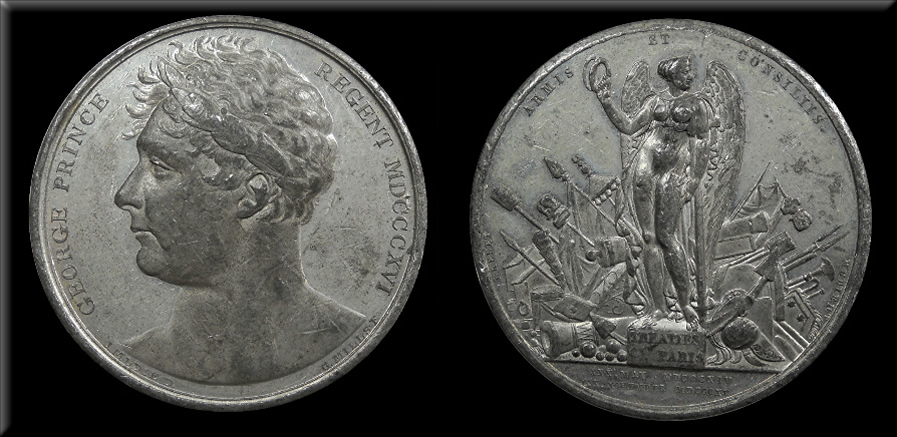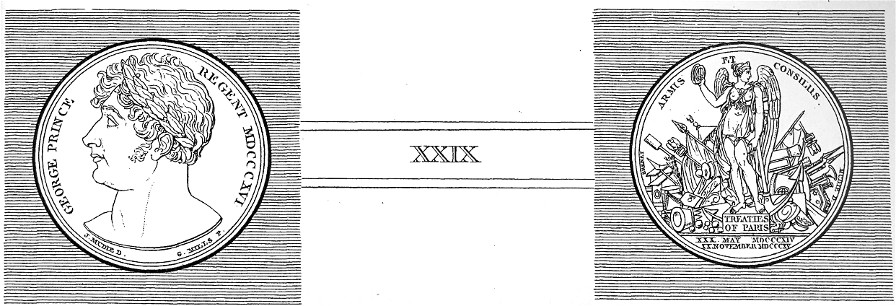Treaties of Paris - 1814 / 1815

Side 1: GEORGE PRINCE REGENT MDCCCXVI |
Side 2: Above: ARMIS ET CONSILIIS. |
Bramsen 2322, British Historical Medals 892 - Mudie Series 29 (1820) |
Mm. 41- White metal |
Engravers:Mills & Brenet |
|
Bramsen - 2322 (Mills & Brenet) Paix de Paris 1814 et 1815 (Description) |
|
Comme celui du N°. 1438 |
Rev: En haut: ARMIS ET CONSILIIS. La Paix debout, s'appuyant à une ancre, est entoureé des trophées. Sur une tablette, en bas: TREATIES OF PARIS. Exergue: XXX. MAY MDCCCXIV XX. NOVEMBER MDCCCXV. |
|
Médaille, 41 mm. - Mudie XXIX. |
|
British Historical Medals - 892 - THE TREATIES OF PARIS, 1814/1815 |
|
AR, AE 41 by G. Mills and and N.G.A. Brenet |
|
Obv. Similar to No. 776 [Laureate head of the Prince Regent, left. GEORGE PRINCE REGENT MDCCCXVI] |
Rev. Peace standing holding two victor's wreaths on a plinth inscribed TREATIES / OF PARIS. A trophy of arms behind her ARMIS ET CONSILIIS (By force and diplomacy). In exergue: XXX. MAY MDCCCXIV XX. NOVEMBER MDCCCXV. |
AR R; AE N. Fi. 5214; M 29. AM; HC. |
|
A further Peace Treaty was signed with France on 20th November 1815, after Napoleo's defeat at Waterloo. By this treaty France was confined to her old frontiers held in 1790 and deprived of the additions granted to her in 1814. A levy of 700,000,000 francs was imposed upon France as a contribution towards the allied costs of the war; the amount was to be paid within five years. |
|
Mudie Series n. XXIX - Treaties of Paris - Description of the medal |
 |
...OBVERSE. - Bust of the Prince Regent.
...REVERSE. - The hope of Europe, that the long and devasting war might to be crowned with peace, is here allegorically represented by a figure of Peace, with wings at rest, reclining on an anchor amidst trophies of war conquered from France, among which is the significant emblem of the annihilated power of Buonaparte - a broken eagle. In her hand is a serpent, the type of Wisdom, and suitable to that direction of affairs which, in union with physical power, obtained the result of peace. On a pedestal supporting the figure is inscribed "TREATIES OF PARIS." On the exergue "30TH MAY, 1814; 20TH NOVEMBER, 1815." Above is the inscription, "ARMIS ET CONSILIIS," an inscription well appropriated to the power and the counsels which achieved the great result of peace. |